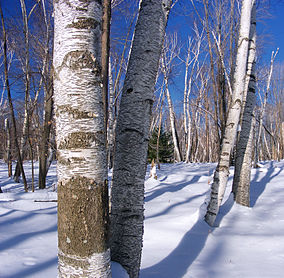- Marion Brooks Natural Area
-
Marion Brooks Natural Area IUCN Category V (Protected Landscape/Seascape)
White birches in Marion E. Brooks Natural AreaLocation within Pennsylvania Location Benezette Township, Elk County, Pennsylvania Coordinates 41°16′35″N 78°17′16″W / 41.2763°N 78.2879°WCoordinates: 41°16′35″N 78°17′16″W / 41.2763°N 78.2879°W[1] Area 917 acres (371 ha) Marion Brooks Natural Area is a state forest natural area in the Moshannon State Forest in Benezette Township, Elk County in the U.S. state of Pennsylvania. The 917-acre (371 ha) natural area is on the northwest edge of Quehanna Wild Area.[2] Marion Brooks Natural Area, known for its large stand of White Birch, was formerly known as Paige Run Natural Area; in 1975 it was renamed for Marion E. Brooks, a pioneering environmentalist from Elk County.[3][4]
White birch
Paper birch, or Betula alba var. papyrifera, is a large tree usually reaching a height of 50–75 feet (15–23 m), with a diameter of 1–23 inches (25–580 mm), but it may reach a height of 80 feet (24 m) with a diameter of 8 feet (2.4 m).[5] Generally the tree is shade-intolerant,[6] and, when grown in the open, trunks are usually short and thick; lateral, often ascending branches cover the trunk from the base. When grown in close stands, most of the trunk is branch-less base and bears a narrow open head. The bark of the trunk and older branches is chalky to creamy white, and peels in layers that are tinged in yellow and covered with horizontally-elongated lenticels. On older trunks, the bark is often rough and fissured with irregular thick scales. The twigs are stout, viscid, with first greenish hairy covering that later becomes smooth and reddish brown in color. After several years, branches turn a bright white, like the trunk, and are covered with pale, horizontally-elongated and orange-colored lenticels.[7]
Birch buds may be ovate, sharp-pointed, and divergent, about .5 inches (13 mm) long, dark, almost chestnut brown in color, and covered with a few overlapping bud scales. These usually have downy margins. The leaves alternate, with simple ovate, 2–3 inches (51–76 mm) long, and 1.5 to 2 inches (38 to 51 mm) wide. They are firm in texture, the upper surface being dark green and the under surface light green. They are narrowed or rounded at the base, sharply toothed on the margin, and have a sharp-pointed apex. Flowers appear in late April or May, before the leaves. The staminate are arranged in layers which occur in groups of 2-3 and are about .1 to .15 inch (2.5 to 3.8 mm) long. They become longer, 3.5 to 4 inches (89 to 100 mm), in the spring. The pistillate have light green lanceolate scales and red styles, and appear in clusters 1 to 1.5 inches (25 to 38 mm) long. The fruit is cylindrical, with a short-stalked strophile about 1.5 inches (38 mm) long. The scales are long, with thick, lateral lobes, and a long terminal lobe. Seeds and small and winged, and the wings are wider than the nut. The wood, a hardwood, is diffuse, porous, rays are small and inconspicuous. The wood itself is light in color, usually light brown, tinged with red, and with thick light sap wood, and its weight is 37.11 pounds (16.83 kg) per cubic foot.[7]
It is strong wood, once used extensively in the manufacture of spools, shoe lasts, pegs, fuel, and in the manufacture of paper pulp,[8] but also in by Native Americans in the construction of horns, canoes, snowshoe frames, and as coverings for the Long houses characteristic of the Iroquois and associated nations. In canoes, the bark that touched the wood was the side that touched the river, and the resulting canoe could be very strong, useful in rapids or in ocean travel. Native Americans also boiled the sap of paper birch to make a syrup.[9]
The Paper birch is also known as canoe birch and white birch, but should not be confused with the European white birch, another deciduous tree that grows in thickets along roadsides, pastures and waste ground.[10]
Range
Although its range extends from Newfoundland to Alaska, and as far south as Michigan, Colorado and Washington, it is only found in the northern part of Pennsylvania, and in scattered instances in Tioga and adjoining counties. Its habitat is usually wooded sloops with rich soils, such as that found on the borders of lakes, swamps, and streams. The white birch occasionally appears in coniferous forests, and makes scattered appearances among other hardwoods.[7]
References
- ^ "Marion Brooks Natural Area State Natural Area". protectedplanet.net. http://protectedplanet.net/sites/Marion_Brooks_Natural_Area_State_Natural_Area.
- ^ "Elk Scenic Drive: An Adventure in 23 Chapters" (PDF). Pennsylvania Department of Conservation and Natural Resources. http://www.pawilds.com/stay-informed/download-pdf-guides/download.aspx?id=280. Retrieved March 16, 2010. Note: this includes four chapters on sites within the Quehanna Wild Area, Marion Brooks Natural Area (3), Beaver Run Dam Wildlife Viewing Area (4), Hoover Farm Wildlife Viewing Area (5), and Wykoff Run Natural Area (6).
- ^ Fergus, Charles (2002). "Chapter 32. Marion Brooks Natural Area". Natural Pennsylvania: Exploring the State Forest Natural Areas (1st ed.). Mechanicsburg, Pennsylvania: Stackpole Books. pp. 117–120. ISBN 0-8117-2038-1. http://books.google.com/books?id=E9PJxejJsigC&printsec=frontcover&source=gbs_v2_summary_r&cad=0#v=onepage&q=&f=false. Retrieved 2010-02-28.
- ^ McGeehan, Dennis (2007). Elk County. Images of America. Charleston, South Carolina: Arcadia Publishing. p. 113. ISBN 978-0-7385-5479-2. http://books.google.com/books?id=ctwbAkK_KfkC&pg=PA113&lpg=PA113&dq=Quehanna+white+birch&source=bl&ots=D0LH2b3ZIn&sig=YOXHEeionuFYvtmwABQCj9tA-Ek&hl=en&ei=sjGdS_Yswv7wBtrosJ8O&sa=X&oi=book_result&ct=result&resnum=5&ved=0CBcQ6AEwBDgK#v=onepage&q=Quehanna%20white%20birch&f=false.
- ^ Joseph Illick, ‘’Pennsylvania trees. “White Birch”. Pennsylvania Department of Forests. Harrisburg: Wm Stanley Ray, 1914, p. 114.
- ^ Charles Fergus, Trees of Pennsylvania and the Northeast, Mechanicsburg, PA: Stackpole Books, ISBN 08117209262002, p. 92.
- ^ a b c Illick, p. 114.
- ^ Illick,p. 114
- ^ Fergus, p. 92
- ^ Ann Fowler Rhoads. The vascular flora of Pennsylvania. Philadelphia:American Philosophical Society, 1993. ISBN 0871692074, p. 76.
Categories:- IUCN Category V
- Protected areas of Elk County, Pennsylvania
Wikimedia Foundation. 2010.

